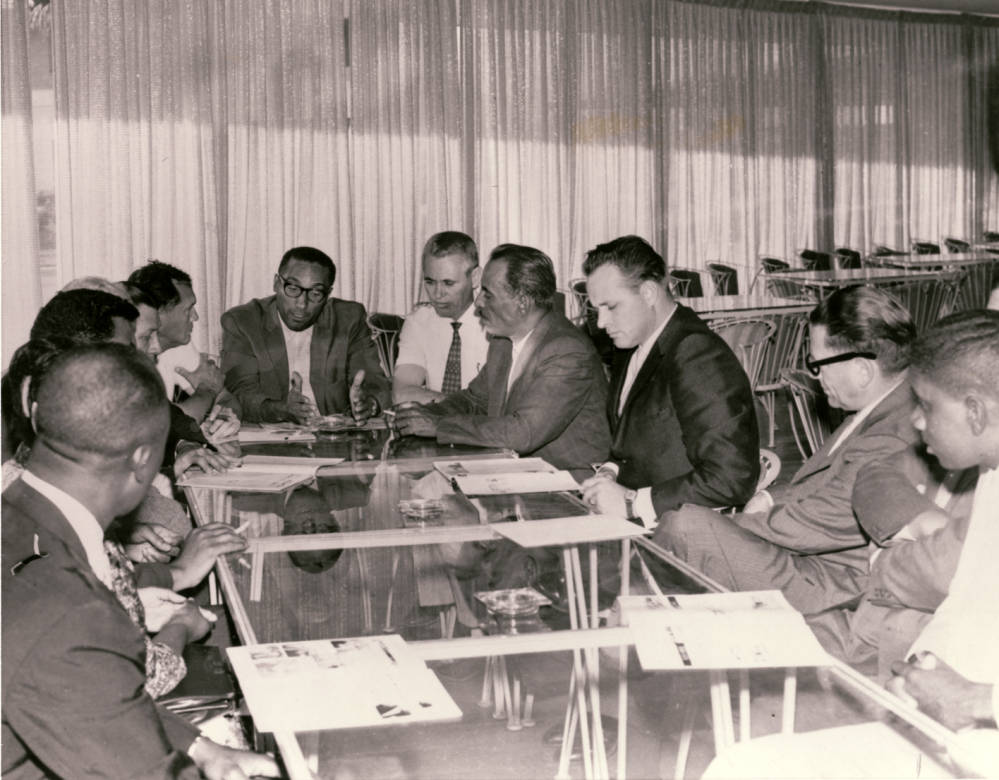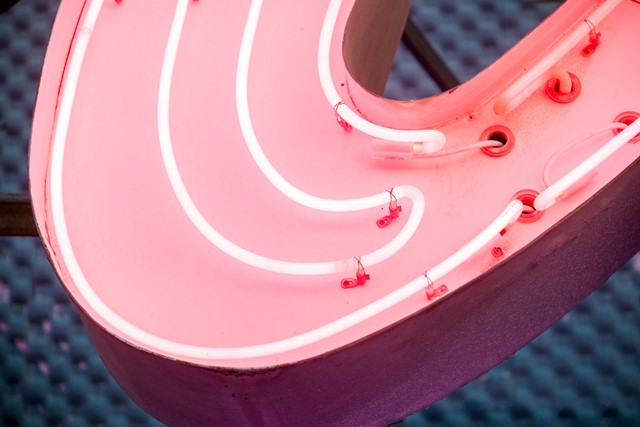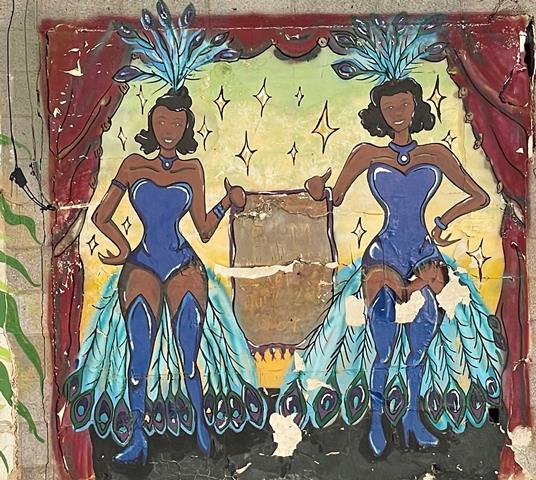Discovering Black History in Las Vegas: A Guide to Civil Rights Sites

Las Vegas may be an adult playground with shows, spas and acres of casinos, but tucked away in hidden corners, you’ll find traces of civil rights history. It should be no surprise. For much of the 20th century discrimination was rampant in the region, earning Nevada the nickname: “the Mississippi of the West.”
The Black Las Vegas history sites covered here are located within just a few miles of each other, and can easily be seen in an hour or two:
- Most center on the fun and retro Neon Museum, which preserves traces of the city’s flashy early days, and puts a spotlight on a pioneering Black architect.
- Nearby, a wall of murals, painted in the months after George Floyd’s murder, marks the site of the city’s first integrated casino, the Moulin Rouge.
- And a statue of Martin Luther King remembers a 1964 visit.
Moulin Rouge, Las Vegas’ first integrated casino

Las Vegas was a segregated city in the 1950s. Black customers couldn’t eat or gamble in the major hotels, and those that worked in casinos had to enter through the back service entrance. Although Nevada did not have Jim Crow laws, the code was strictly followed.
Initial signs of change came in May 1955, when the Moulin Rouge opened as the first integrated casino. Although it was majority White-owned, professional boxer Joe Louis, an African American, was a partial shareholder.
The Rouge wasn’t shy about its status, declaring in promotional material: “”For years, men have dreamed of a resort where everyone would be welcomed regardless of color, race or creed. Today, that bold dream has come true in Las Vegas, and it has come true in breathtaking fashion.”
“The Moulin Rouge sign is the city’s most important civil rights artifact.”
The 110-room hotel had a swimming pool and a replica Eiffel Tower. Its late night Tropi Can show included the city’s only all-Black chorus line. The Rouge was especially popular for its 2:30 a.m. “third show,” which attracted casino performers of all races, who would stop by after they finished their shifts. But the casino wasn’t a commercial success. Over the years, the Rouge went in and out of business, and often sat vacant. It had several owners including Sarann Knight Preddy, the first black woman awarded a gaming license in Nevada.
But The Rouge’s most important moment came in 1960 when Black leaders and the NAACP demanded the integration of the city’s casinos, threatening mass protests along the Strip. The possibility caught the attention of white leaders, including Nevada’s governor along with the city’s mayor, police chief, county sheriff, and the leading newspaper publisher.

On Saturday morning, March 25, 1960, the group met with Black leaders in the coffee shop of the Rouge, which was closed at the time, and by the time they left they had reached an agreement to immediately integrate the city’s major casinos. That night, several NAACP leaders and their families visited the Strip to test the deal, and successfully attended shows, ate at restaurants and purchased chips at gambling tables.
The handshake pact became known as the Moulin Rouge Agreement, which is one of the reasons the casino was added to the National Register of Historic Places in 1992.
The Neon Museum’s Black Las Vegas history

Although the casino’s long gone, you can still sense its glamour at the Neon Museum, and its “Boneyard” of historic, refurbished signs on the edge of downtown.
Walking through its outdoor showroom is like wandering through the city’s attic. Many old signs glow again, making the best time to visit just before sundown. That’s when the flashing lights, hard to detect in the bright desert sunlight, start to become visible.
Visitors enter the museum through an important artifact with a tie to Black history: the lobby of the former La Concha Hotel. The shell-shaped concrete building was designed by famed Black architect Paul Revere Williams, and is considered a masterpiece of Googie-style space-age design. Williams worked in Los Angeles, where he designed Hollywood homes for clients including Frank Sinatra and Lucille Ball. He was the first African American admitted into the American Institute of Architects.

La Concha once stood on the Las Vegas Strip, but the shell was moved across town to the Neon Museum, where it makes a wonderful welcome center. Inside the Boneyard, you can also see a La Concha neon sign which echoes the building’s distinctive design. Other La Concha memorabilia on display include matchbooks, a hotel key and photos of the building in its glory days.
But our destination is the Moulin Rouge sign, which stands near the front of the oval pathway that winds through the exhibit area. Restored in 2020, its tall swirly letters once again glow in neon pink.
This is probably the most important civil rights artifact the city because it preserves a link to a landmark building, which unfortunately no longer stands.

Some fun facts about the sign: The letters stand from 14 to 18 feet tall and 3 to 17 feet wide, and weigh more than 1,000 pounds. It was designed by Betty Willis, one of the few female signmakers of the era, and it depicts her actual handwriting. Many people know her famous “Welcome to Fabulous Las Vegas” sign that stands at the end of the Strip.
Other Boneyard artifacts with a civil rights history include the giant shoe that once marked the Silver Slipper casino. It hosted an NAACP Black History Month program in the 1950s, when it was difficult to rent a room for a Black event.

Also look for signs from Fitzgerald’s, which was once owned by Don Barden, one of the few Black casino owners in the nation.

Outside the museum, you’ll find murals on the wall past the parking lot. Several images honor African Americans, including architect Williams, who is shown at his desk working on the design for La Concha.

Also keep an eye out for Sammy Davis Jr., a member of the famed Rat Pack. The singer, dancer and comedian was also an important civil rights activist during the 1960s. Davis became the first Black guest to spend the night in the White House when he was invited by President Richard Nixon.
Another mural shows showgirl Theodora Boyd, who performed at the Moulin Rouge and won fame as back-up dancer for jazz band leader Cab Callaway.
Black history murals on Bonanza Road

Like most landmarks in Las Vegas, the Moulin Rouge didn’t last. It went out of business and sat in disrepair for years, and eventually was destroyed by arson in 2009. However, the building site took on a renewed importance in 2020 following the murder of George Floyd in Minneapolis.

Volunteer artists decorated the abandoned lot with murals, some inspired by the Black Lives Matter movement. Another work shows the Moulin Rouge sign. Paintings honor Breonna Taylor, and showgirl Theodora Boyd. A striking mural of Martin Luther King Jr. includes his famous quote: “I have decided to stick with love. Hate is too great a burden to bear.”

The murals are located at 900 West Bonanza Road. It’s an isolated area in the shadow of downtown. There appears to be a small homeless camp nearby, so be respectful during your visit.
King statue in North Las Vegas

The last important civil rights stop is a larger-than-life statue of Martin Luther King in Las Vegas’ Westside neighborhood, home to the city’s historic Black community. The five-ton statue, located in front of the Clark County Community Resource Center, commemorates King’s only visit to the city in 1964. He came to speak at the Las Vegas NAACP’s Freedom Banquet and later at a public rally at the Convention Center. King was invited by a classmate from Morehouse College, and spent the night at the Sands Hotel and Casino, amid tight security.
According to newspaper coverage at the time, King spoke in support of the 1964 federal Civil Rights Act during his visit. “We will match your capacity to inflict suffering with our capacity to endure suffering,” he said to “ringing cheers.”
The statue by the late artist Tina Allen depicts King in a minister’s robe, grasping a Bible, a copy of the Constitution, and a small globe. The sculptor is quoted as saying: “He holds the world out to you as if to say, and ‘I’ve given my all. Now it’s up to you. Treat the world gently. Remember what you do affects us all.” Erected in 2001, it’s a handsome statue surrounded by palm trees and makes for a striking photo.
It’s located on the intersection of Martin Luther King Boulevard and Carey Avenue, 1344 W Carey Ave, North Las Vegas, NV 89030
Guidebook
Black-owned restaurants
There are plenty places to dine in Vegas, but here are some Black-owned restaurants to consider:
Gritz Cafe The closest thing you’ll find to Southern cooking in the city.
Simple Pure Yes you can find healthy food in Sin City. Try out the vegan offerings.
Nigerian Cuisine By Mj Las Vegas is a long way from Lagos, but here’s a spot for authentic African cuisine.
Big Jerk Caribbean Head here for a spicy taste of Jamaica.
Lodging
Finding a Vegas hotel can be a gamble. Prices vary wildly based on demand with costs climbing during large conventions and holidays. But deals can be found. Click here to find the best cheap hotels in Las Vegas, curated by Booking.com

